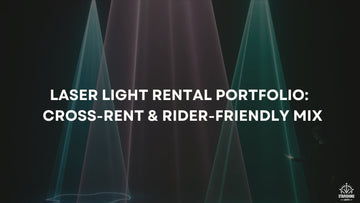
- Cross-rentability is rider acceptance + low transit friction + known console/server profiles.
- A/B/C pyramid (≈50–60% A, 30–40% B, 10–15% C) balances turns, approvals, and margin.
- IP65 in B/C raises weekend premiums and reduces weather risk on outdoor circuits.
- Track the math: utilization + rider dispute rate predicts cash conversion better than gut feel.

Intercity Pooling & Co-Op Logic
- Days on hire from partners: how often and how long units leave home base.
- Rider acceptance without substitution: fewer email chains, faster confirmations.
- Transit friction: case weight/size, IP65, rigging footprint, and power draw.
- Metro↔metro corridors: Friday-out/Monday-in cycles for stage laser lights.
- Weather lanes: spring–summer spikes for professional outdoor laser light projector kits.
- Transport math: Lane Cost ≈ (case weight × distance × fuel) + crew hours + rig time − pooling discount.

Rider-Friendly Power Bands & Brand Gravity
| Band | Typical Power | Use Case | Pros | Watch-outs |
|---|---|---|---|---|
| A | 2–6 W RGB | Clubs, pop-ups | Fast turns, lighter cases | Limited long-throw; fewer “rider” wins |
| B | 8–15 W IP65 | Tours, festivals | “Rider friendly laser”, strong cross-rent | Higher CAPEX; protect availability |
| C | 20–30 W+ | Broadcast, stadium | Premium rates, brand halo | Lower util%; heavier logistics |

Three-Tier Inventory Pyramid
- 50–60% Band A: the local workhorses—quick turns and steady cash.
- 30–40% Band B: rider-safe anchors with better margins and strong cross-rent.
- 10–15% Band C: halo units for festivals/broadcast; lower util% but premium rates.
| Model | Band | IP | Weight | Day Rate | Week Rate | Util% | Break-Even Days | Cross-Rent Premium | Notes |
|---|---|---|---|---|---|---|---|---|---|
| Laser-A 6W | A | IP20 | 28 kg | $140 | $490 | 52% | 41 | +8% | Club pop-ups |
| Laser-B 12W | B | IP65 | 34 kg | $260 | $910 | 40% | 55 | +15% | “Rider friendly laser” |
| Laser-C 25W | C | IP65 | 42 kg | $420 | $1470 | 24% | 68 | +22% | Stadium/Broadcast |
| KPI | Formula | Target | Action Lever |
|---|---|---|---|
| Break-Even Days | CAPEX ÷ (Day Rate − Daily Cost) | ≤ 60 | Raise rate; trim lane/maintenance cost |
| Fleet Utilization | Billable Days ÷ Available Days | A: 45–55%, B: 35–45%, C: 20–30% | Optimize metro lanes; protect B-band |
| Cash Conversion | ((Billable×Rate) − All Costs) ÷ CAPEX | ≥ 2.5×/yr | Cross-rent premium; weekend/IP65 premiums |
| Rider Dispute Rate | Disputes ÷ Rider Requests | ≤ 5% | Standardize brands, profiles, labels |
East-Coast Festival Pooling. A/B/C mix 55/35/10 with IP65 on B/C tiers increased cross-rent confirmations by 23% in 8 weeks; standardized cases + QR check-in cut late-return headaches.
National Co-Op Network. Shared calendar and a pre-approved substitution list cut rider challenges by ~40%. Band-B delivered the best cash conversion across three partners.
Broadcast & Sports Halftime. C-band units landed premium day rates; pre-built console/media-server templates trimmed tech rehearsal by ~30 minutes per show.
How many units per tier should I start with?
Begin around 60/30/10 (A/B/C) or 50/35/15 if your city leans touring. Rebalance quarterly from utilization and dispute logs.
When is a cheaper non-rider model a false economy?
When substitutions trigger delays or extra crew. Track dispute rate and added labor against CAPEX saved—then adjust the mix.
Should I prioritize IP65 laser models?
Yes for outdoor lanes. IP65 reduces cancellations and enclosure rentals and improves utilization.
How do I reduce rider disputes?
Standardize “rider friendly laser” families, publish console/media-server profiles, and include interlocks/E-Stops with clear labels in every case.
Can Starshine support bulk and OEM/ODM?
Yes—bulk buys, OEM/ODM faceplates, matched roadcases, and factory spares packs tied to your serials. We’re a manufacturer partner, not just a reseller.




























